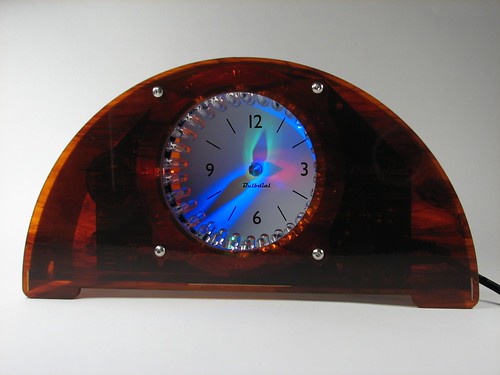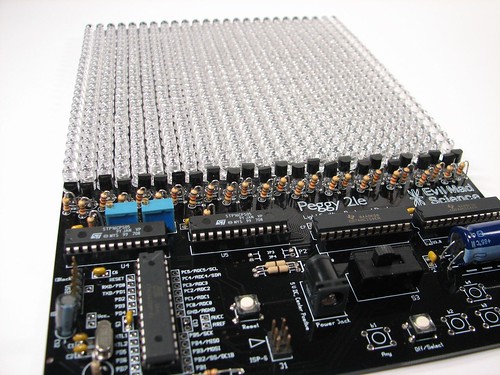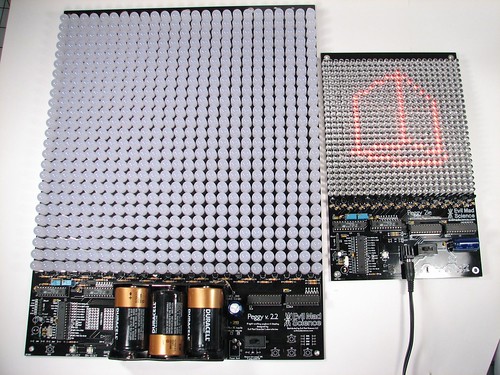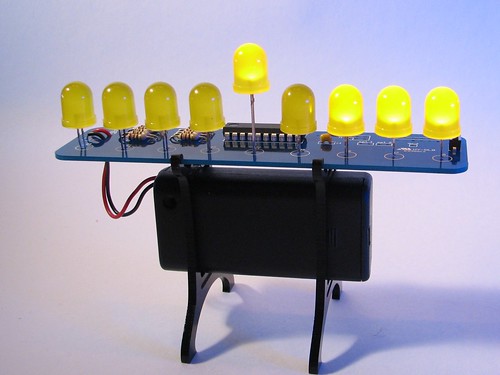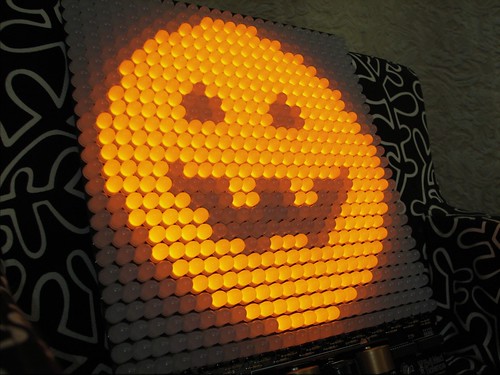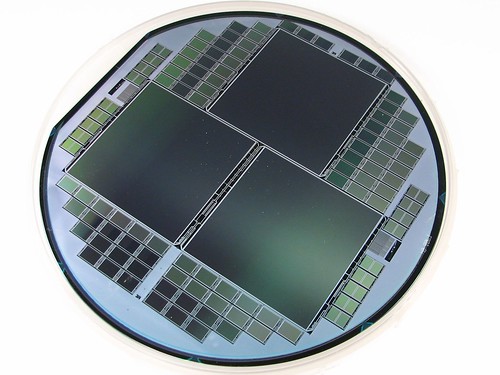Back in April, we posted a little project in which we demonstrated a simple Bulbdial clock, based on the original concept from IronicSans.com. We had a lot of feedback on the original project. We listened to it, learned from it, and finally designed a kit around the concept.
Category Archives: Engineering
Peggy 2LE
It’s new… and we shall call it Mini Peggy.
Peggy 2LE (“little edition”) is a diminutive version of our popular Peggy 2 LED “pegboard” an open-source LED matrix display. Peggy 2 is big, designed to fit a 25×25 grid of 10 mm LEDs. Peggy 2LE is mostly the same, just smaller: it’s designed to fit 5 mm LEDs.
Here’s the family photo: Big ol’ Peggy next to the new Mini Peggy, Peggy 2LE.
Continue reading Peggy 2LE
YOU HAVE EIGHT EARTH MINUTES LEFT
Okay, maybe that’s a bit of an exaggeration. But, the deadline for our Arduino Contest at Instructables is approaching right fast: Entries are accepted until this Sunday, Nov 15, 2009, at 11:59 PM PST.
Why enter? To show off your cool stuff! Also, you could win a Meggy Jr RGB handheld gaming kit, or an Arduino Mega or other nice goodies, so don’t you want to come out and play?
Official contest rules are here. The basic entry requirement is that you make a project that involves the Arduino IDE in some way, and you can already check out many of the great projects entered. Woo!
Refining Edge-Lit Holiday Cards
We’ve picked up a bunch of improvements on our Edge-Lit Holiday Cards since last year and we’ve collected them here for you to see. (Also, welcome Popular Science readers! This project is mentioned in the December 2009 issue.)
New LED Hanukkah Menorah Kit
One of our first kit projects, and one of the consistently most popular, has been the LED Mini Menorah project. For a couple years now we have meant to revisit that project, and we’ve finally got around to doing so. Here is the result: our new Deluxe LED Menorah Kit.
Contest reminder!
We’ve seen a lot of great Arduino Halloween projects out there this year. A few of them have been submitted to our Arduino contest over at Instructables, and we’d love to see more. The entry deadline is Nov. 15, so you’ve still got time to send them in.
Speaking of contests, the Make Halloween contest deadline is here. Quick, get those microcontroller projects entered before midnight on Nov. 3!Peggy-O-lantern
Lately we have been working on a new version of the PeggyDraw program, which is a program that lets you draw things that you want to display on the Peggy 2 for static images. The new version isn’t quite ready to show off this week, which is too bad because we like to put out our Peggies for halloween.
On the bright side, Mark Delp just sent in a program called bmp2peg that’s been added to the Peggy project at Google Code. It converts a (tiny) windows BMP file and generates an Arduino sketch that can run on the Peggy. (bmp2peg runs on windows, and also on linux if you recompile it, macs unknown thus far.) Both bmp2peg and the original cross-platform PeggyDraw can be used to put static images on the Peggy, or to generate static frames that you swap out in the code to build simple animations. The window-friendly pumpkin above was drawn as an image file, converted with bmp2peg, and installed on a Peggy 2 filled with orange LEDs.
Last year at halloween we took a different approach to the Peggy in the window. We took one filled with red LEDs, and every twenty seconds (or so) it would flash the letters “BOO” — huge and bright — and then go dark again. We took a little movie of this last year, showing how that works.
(The flickr video is embedded below — if you can’t see it, click through to see it.)
The video is very dark, but it’s accurate: our street really is that dark on Halloween. You have to walk slowly because you can’t see where the sidewalk is.
You can find more Halloween decor projects in our Halloween Project Archive.
Rovin Pumpkin
The Rovin’ Pumpkin’ is a simple robotic pumpkin, and a close cousin of the Snap-O-Lantern. Silently, it sits on your porch– camouflaged amongst the humble squashes.
After a minute, its green eyes start to glow, and it creeps… moving about one foot to the left… and stops. The eyes go dark again. It fades into the darkness. And it waits.
An interesting wafer
I picked up this interesting wafer at the silicon valley electronics flea market. So far as I can guess, these are some sort of image sensors. The manufacturer has cleverly divided the wafer up to make three different sizes of sensors at the same time– only three of the large ones, and many more in the two smaller sizes.
So, before I pull out the microscope and look for brand names, can anyone guess (or identify) *exactly* what we’re looking at here? For scale, the wafer is about six inches across. A few more pictures follow.
Continue reading An interesting wafer
Instructables Arduino Contest
Over at Instructables, we’re sponsoring an Arduino contest with prizes including Meggy Jr RGB kits. The rules are simple: use Arduino in your project! And by Arduino, we mean any project involving the Arduino IDE in some way. (And yes, you can use your Meggy Jr RGB or your Peggy 2 for this contest.) We look forward to seeing your projects and would love to see them in the flickr auxiliary, too.




